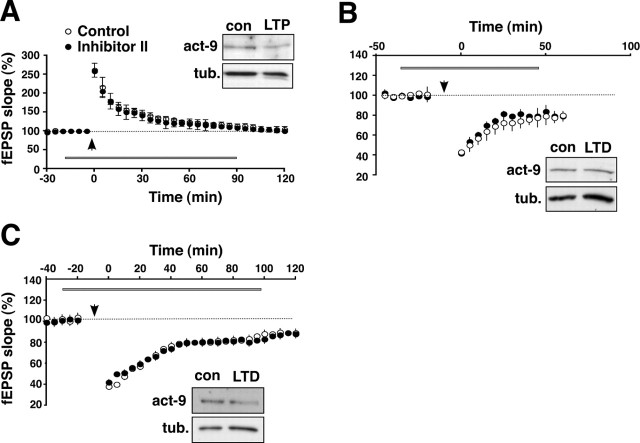MMP-9 has no role in, nor is regulated during, other forms of synaptic plasticity. A, Rat hippocampal slices subjected to a weak tetanic stimulation protocol that produces E-LTP (arrow; a single train of 100 Hz, 1 s tetanic stimulation; open circles). Slices bath exposed to the MMP-2/9 inhibitor (Inhibitor II, 50 μm; filled circles) exhibit E-LTP that is indistinguishable from that elicited in control slices, indicating that MMP-9 has no role in this form of plasticity. Consistent with this, the inset shows a representative immunoblot of area CA1 homogenates frozen 60 min after stimulation; levels of the active form of MMP-9 are unchanged in the decrementally potentiated slices compared with control (con) slices. B, Rat hippocampal slices were subjected to a tetanic stimulation protocol that produces an NMDA receptor-dependent form of synaptic depression (LTD; open circles). Exposing slices to the MMP-2/9 inhibitor had no effect on LTD (filled circles), indicating that MMP-9 has no role in this form of LTD. Consistent with this, the inset shows a representative immunoblot of area CA1 homogenates frozen 60 min after stimulation (LTD); levels of the active form of MMP-9 are unchanged compared with control slices. C, Rat hippocampal slices were subjected to a tetanic stimulation protocol that produces a long-lasting protein synthesis-dependent form of synaptic depression (LTD; open circles). Exposing slices to the MMP-2/9 inhibitor had no effect on LTD (black circles), indicating that MMP-9 has no role in this form of LTD. Consistent with this, the inset shows a representative immunoblot of area CA1 homogenates frozen 60 min after stimulation; levels of the active form of MMP-9 are unchanged compared with control slices. con, Control; act, active form; tub., tubulin.

An official website of the United States government
Here's how you know
Official websites use .gov
A
.gov website belongs to an official
government organization in the United States.
Secure .gov websites use HTTPS
A lock (
) or https:// means you've safely
connected to the .gov website. Share sensitive
information only on official, secure websites.
